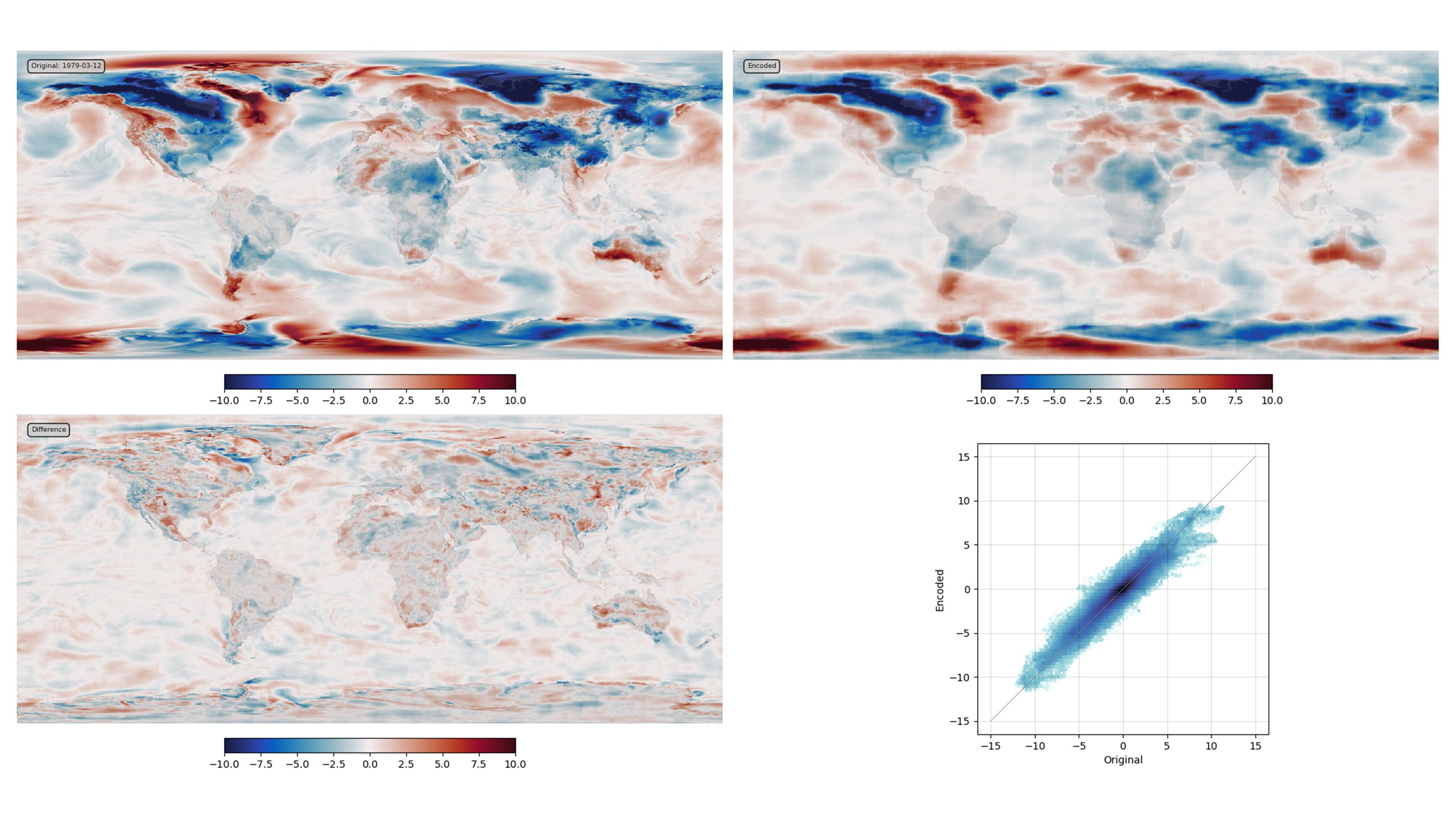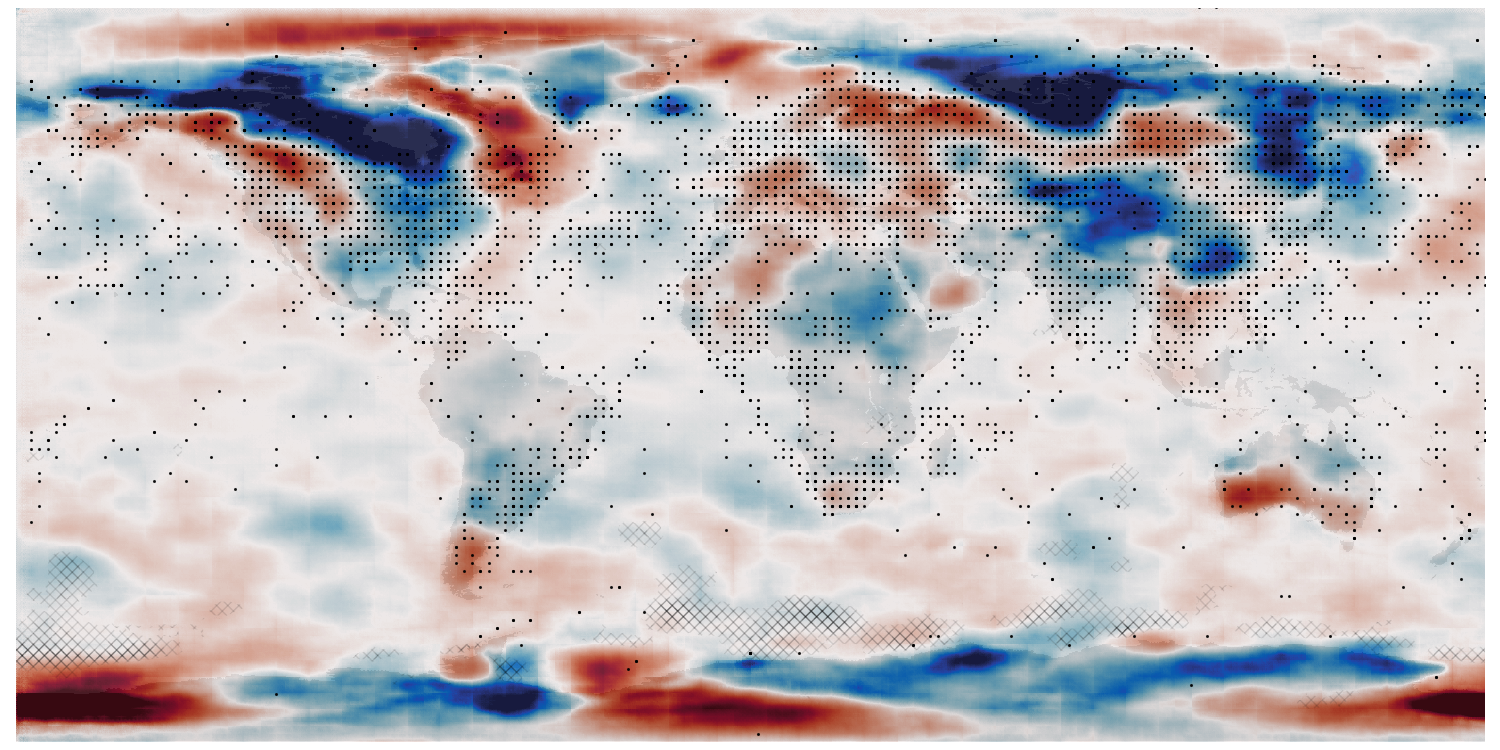ERA5 T2m - validate the trained VAE¶

VAE validation: top left - original field, top right - generator output, bottom left - difference, bottom right - scatter original::output. (Note that a substantially better result could be produced with more model-building effort and a larger latent space, but this is good enough for present purposes).¶
Script to make the validation figure
#!/usr/bin/env python
# Plot a validation figure for the autoencoder.
# Fir components
# 1) Original field
# 2) Encoded field
# 3) Difference field
# 4) Original:Encoded scatter
#
import tensorflow as tf
import os
import sys
import numpy as np
import matplotlib
from matplotlib.backends.backend_agg import FigureCanvasAgg as FigureCanvas
from matplotlib.figure import Figure
import argparse
parser = argparse.ArgumentParser()
parser.add_argument("--epoch", help="Epoch", type=int, required=True)
parser.add_argument("--year", type=int, required=False, default=1979)
parser.add_argument("--month", type=int, required=False, default=3)
parser.add_argument("--day", type=int, required=False, default=12)
args = parser.parse_args()
sys.path.append(
"%s/../../../data/prepare_training_tensors_ERA5_T2m" % os.path.dirname(__file__)
)
from ERA5_load import ERA5_load_T2m
from ERA5_load import ERA5_load_T2m_climatology
from ERA5_load import ERA5_roll_longitude
from ERA5_load import ERA5_trim
# Make the input tensor for the specified date
t = ERA5_load_T2m(args.year, args.month, args.day)
c = ERA5_load_T2m_climatology(args.year, args.month, args.day)
t = t - c
t /= 15
t += 0.5
t = ERA5_roll_longitude(t)
t = ERA5_trim(t)
t_in = tf.convert_to_tensor(t.data, np.float32)
t_in = tf.reshape(t_in, [1, 720, 1440, 1])
sys.path.append("%s/." % os.path.dirname(__file__))
from plot_ERA5_comparison import get_land_mask
from plot_ERA5_comparison import plot_T2m
from plot_ERA5_comparison import plot_scatter
from plot_ERA5_comparison import plot_colourbar
# Define the model
sys.path.append("%s/.." % os.path.dirname(__file__))
from autoencoderModel import DCVAE
autoencoder = DCVAE()
weights_dir = ("%s/Proxy_20CR/models/DCVAE_single_ERA5_T2m/" + "Epoch_%04d") % (
os.getenv("SCRATCH"),
args.epoch,
)
load_status = autoencoder.load_weights("%s/ckpt" % weights_dir).expect_partial()
# Check the load worked
load_status.assert_existing_objects_matched()
# Make encoded version
encoded = tf.convert_to_tensor(autoencoder.predict_on_batch(t_in), np.float32)
# Make the figure
lm = get_land_mask()
fig = Figure(
figsize=(20, 10),
dpi=100,
facecolor=(0.88, 0.88, 0.88, 1),
edgecolor=None,
linewidth=0.0,
frameon=False,
subplotpars=None,
tight_layout=None,
)
canvas = FigureCanvas(fig)
ax_global = fig.add_axes([0, 0, 1, 1], facecolor="white")
ax_global.set_axis_off()
ax_global.autoscale(enable=False)
ax_global.fill((-0.1, 1.1, 1.1, -0.1), (-0.1, -0.1, 1.1, 1.1), "white")
# Top left - original field
ax_of = fig.add_axes([0.01, 0.565, 0.485, 0.425])
ax_of.set_aspect("auto")
ax_of.set_axis_off()
ofp = plot_T2m(
ax_of,
tf.squeeze(t_in - 0.5).numpy() * 15,
vMin=-10,
vMax=10,
land=lm,
label="Original: %04d-%02d-%02d" % (args.year, args.month, args.day),
)
ax_ocb = fig.add_axes([0.05, 0.525, 0.405, 0.02])
plot_colourbar(fig, ax_ocb, ofp)
# Top right - encoded field
ax_of = fig.add_axes([0.502, 0.565, 0.485, 0.425])
ax_of.set_aspect("auto")
ax_of.set_axis_off()
ofp = plot_T2m(
ax_of,
tf.squeeze(encoded - 0.5).numpy() * 15,
vMin=-10,
vMax=10,
land=lm,
label="Encoded",
)
ax_ocb = fig.add_axes([0.57, 0.525, 0.405, 0.02])
plot_colourbar(fig, ax_ocb, ofp)
# Bottom left - difference field
ax_of = fig.add_axes([0.01, 0.065, 0.485, 0.425])
ax_of.set_aspect("auto")
ax_of.set_axis_off()
ofp = plot_T2m(
ax_of,
tf.squeeze(encoded - t_in).numpy() * 15,
vMin=-10,
vMax=10,
land=lm,
label="Difference",
)
ax_ocb = fig.add_axes([0.05, 0.025, 0.405, 0.02])
plot_colourbar(fig, ax_ocb, ofp)
# Bottom right - scatterplot
ax_scatter = fig.add_axes([0.67, 0.05, 0.2, 0.4])
plot_scatter(ax_scatter, t_in.numpy(), encoded.numpy(), d_max=15, d_min=-15)
fig.savefig("comparison.png")
Utility functions used in the plot
# Functions to plot ERA5 data before and after autoencoding
# Takes data in tensorflow format (no geometry metadata, normalised)
import os
import sys
import math
# import iris
import numpy as np
#import tensorflow as tf
import matplotlib
import cmocean
sys.path.append(
"%s/../../../data/prepare_training_tensors_ERA5_T2m/" % os.path.dirname(__file__)
)
from ERA5_load import ERA5_trim
from ERA5_load import ERA5_roll_longitude
from ERA5_load import ERA5_load_LS_mask
# It's a spatial map, so want the land mask
def get_land_mask():
mask = ERA5_load_LS_mask()
mask = ERA5_roll_longitude(mask)
return ERA5_trim(mask)
def plot_T2m(
ax,
tmx,
vMin=0,
vMax=1,
fog=None,
fog_threshold=0.5,
fog_steepness=10,
obs=None,
obs_c=None,
o_size=1,
land=None,
label=None,
):
if land is None:
land = get_land_mask()
lats = land.coord("latitude").points
lons = land.coord("longitude").points
land_img = ax.pcolorfast(
lons, lats, land.data, cmap="Greys", alpha=0.1, vmax=1.1, vmin=-0.5, zorder=100
)
# Field data
T_img = None
if tmx is not None:
T_img = ax.pcolormesh(
lons,
lats,
tmx,
shading="auto",
cmap=cmocean.cm.balance, #"RdYlBu_r",
vmin=vMin,
vmax=vMax,
alpha=1.0,
zorder=40,
)
# Fog of ignorance
nLevels = 10
levels=np.concatenate(([0],np.linspace(0.33,1,num=nLevels)))
if fog is not None:
cs = ax.contourf(
lons,
lats,
np.minimum(1.0, fog),
levels,
colors="none",
vmin=0,
vmax=1,
hatches=[None]+["///"]*(nLevels-1),
extend="upper",
zorder=500,
)
nCols = len(cs.collections)
alphas = np.linspace(0,1,num=nCols)
for i, collection in enumerate(cs.collections):
collection.set_edgecolor((0,0,0))
collection.set_alpha(alphas[i])
collection.set_facecolor('none')
collection.set_linewidth(0.0)
cs = ax.contourf(
lons,
lats,
np.minimum(1.0, fog),
levels,
colors="none",
vmin=0,
vmax=1,
hatches=[None]+["\\\\\\"]*(nLevels-1),
extend="upper",
zorder=500,
)
for i, collection in enumerate(cs.collections):
collection.set_edgecolor((0,0,0))
collection.set_alpha(alphas[i])
collection.set_facecolor('none')
collection.set_linewidth(0.0)
# Observations
if obs is not None:
x = (obs[:, 1] / 1440) * 360 - 180
y = (obs[:, 0] / 720) * 180 - 90
y *= -1
if obs_c is None:
ax.scatter(
((x / 2).astype(int) + 1) * 2,
((y / 2).astype(int) + 1) * 2,
s=3.0 * o_size,
c='black',
marker="o",
alpha=0.8,
zorder=600,
)
else:
ax.scatter(
((x / 2).astype(int) + 1) * 2,
((y / 2).astype(int) + 1) * 2,
s=3.0 * o_size,
c=obs_c,
cmap=cmocean.cm.balance, #"RdYlBu_r",
vmin=vMin,
vmax=vMax,
marker="o",
alpha=1.0,
zorder=600,
)
if label is not None:
ax.text(
lons[0] + (lons[-1] - lons[0]) * 0.02,
lats[0] + (lats[-1] - lats[0]) * 0.04,
label,
horizontalalignment="left",
verticalalignment="top",
color="black",
bbox=dict(
facecolor=(0.8, 0.8, 0.8, 0.8),
edgecolor="black",
boxstyle="round",
pad=0.5,
),
size=matplotlib.rcParams["font.size"] / 1.5,
clip_on=True,
zorder=100,
)
return T_img
def plot_scatter(ax, t_in, t_out, land=None, d_max=5, d_min=-5,
xlab='Original',ylab='Generated',lw=0.5):
x = (t_in.flatten() - 0.5) * 10
y = (t_out.flatten() - 0.5) * 10
# if land is not None:
# ld = land.data.flatten
y = y[x != 0]
x = x[x != 0]
ax.hexbin(
x=x,
y=y,
cmap=cmocean.cm.ice_r,
bins="log",
mincnt=1,
extent=(d_min,d_max,d_min,d_max),
)
ax.add_line(
matplotlib.lines.Line2D(
xdata=(d_min, d_max),
ydata=(d_min, d_max),
linestyle="solid",
linewidth=lw,
color=(0.5, 0.5, 0.5, 1),
zorder=100,
)
)
ax.set(xlabel=xlab, ylabel=ylab)
ax.grid(color="black", alpha=0.2, linestyle="-", linewidth=0.5)
def plot_colourbar(
fig,
ax,
T_img,
):
ax.set_axis_off()
cb = fig.colorbar(
T_img, ax=ax, location="bottom", orientation="horizontal", fraction=1.0
)
